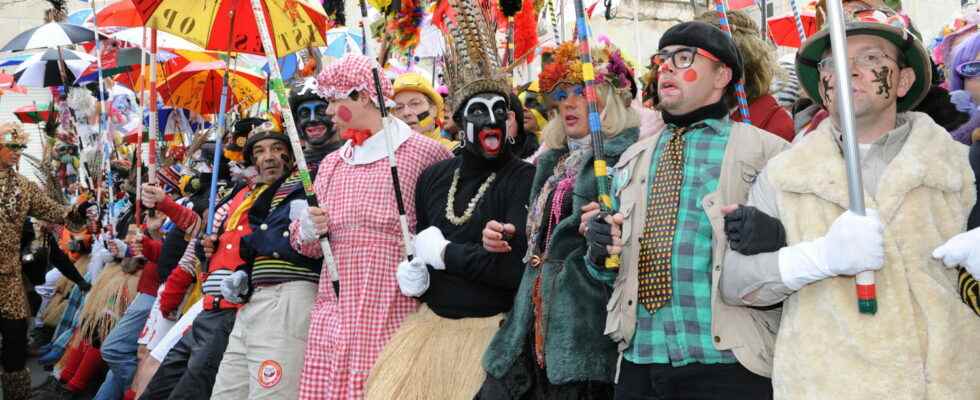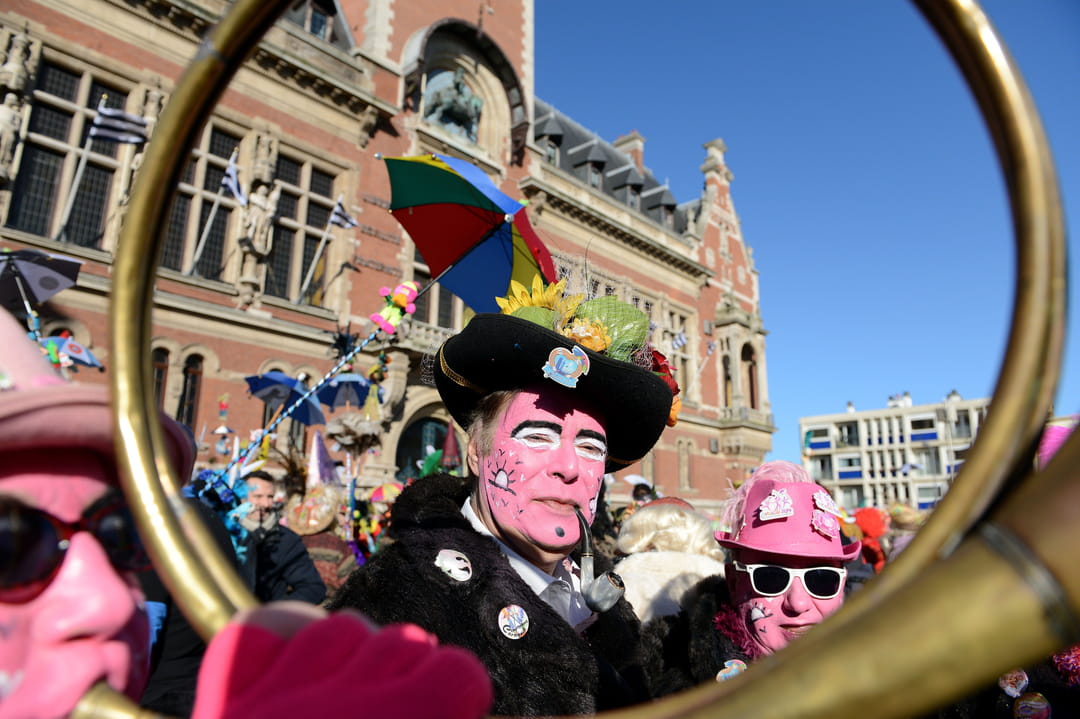DUNKIRK CARNIVAL. The bands will punctuate the Trois Joyeuses which open this Sunday, February 19, 2023 in Dunkirk. Consult the program with date and time.
[Mis à jour le 18 février 2022 à 13h00] From Sunday February 19 to Tuesday February 21, 2023, place aux Trois Joyeuses à Dunkirk, a highlight of the carnival not to be missed under any circumstances! The festivities will begin on Sunday with the band of fishermen “Visschersbende” which will leave at 3 p.m. from Boulevard Sainte-Barbe, led by the drum major “Cô Boont’che”. The famous herring throw will then be held at 5 p.m. in front of the town hall.
The rigodon will take place at 7 p.m. on Place Jean-Bart where the podium is located. Pascal Bonne, drum major of Dunkirk, believes with BFM Littoral that this moment “represents the apotheosis (…) We cannot miss the rigodon, I think that the Dunkirks know it too, because at the end of this final rigodon we have the tribute to Cô-Pinard, to our famous drum major and also we have the anthem to Jean Bart, so I think that you should not miss it at all. This event will be followed by the Bal des Acharnés at the Kursaal.
Monday, February 20, the Citadel band led by the Drum Major “Cacaille 1er” will leave at 4 p.m. from rue L’Hermite, followed by the rigodon on the place de l’Yser from 7 p.m. Tuesday, February 21, the Rosendaël band led by the drum Major “Rosval III” will leave at 3 p.m. from Place Voltaire, followed by a jet of dried fish at 5 p.m. Find below the explanation of these highlights of the event, the popular songs sung and the tradition of the bands and costumes.
The herring throwduring which the mayor of Dunkirk and his municipal councilor throw smoked herrings at the carnival-goers, is one of the carnival events not to be missed, on the first day of the “Three Happy“. This tradition dates back to 1962, when the event was organized for the first time by the merchants’ union. A gesture that recalls what has made the city of Dunkirk rich. Indeed, fishing represents this which fed the coastal populations for many years. After these hours of celebration, the crowd gathers at the foot of the statue of the corsair Jean-Bartin order to offer a tribute to the hero of the city.

On the sidelines of these highlights, balls are organized. The thousands of carnival-goers wear disguises, while the Figueman, emblematic figures of the carnival, intriguing masked characters who carry a stick at the end of which hangs a dirty sock, a fish or a spider, move around and challenge passers-by. Finally, the party continues the week of Mardi Gras with its giant and colorful parades. You may also have the opportunity to enter, by giving a password, in the chapels. The inhabitants also open their house to drink a beer, eat porridge, herring or a soup in a friendly musical atmosphere.
The Dunkirk carnival is an event to experience more than to see: it has its songs and hymns, its mythical characters, its customs and its golden rules. A tide of masquerours are arranged in successive lines, holding each other by the elbows, during the parades of the bands which generally take place on Sunday afternoons. There’s the Dunkirk band, of the Citadel, but also those of Rosendaël then those of Malo, Petite-Synthe, Mardyck… It is important to have a knowledge of this tradition, its popular songs, the preparation of its costume, before embarking on the crazy adventure of the carnival of Dunkirk.

The Dunkirk carnival would be nothing without its 56 specific songs which mainly celebrate the return of spring and fertility, but also the highlights of the history of the city of Dunkirk. Of “In Dunkirk” At “Final” Passing by “Mary Potato” Or “The Gossips of the rue Saint Gilles” or “At yours Etienne“, the people of Dunkirk know the words of these very daring but always cheerful songs! The texts of these songs originate from military songs and transformed fashionable tunes, sometimes alluding to the miserable living conditions after the Liberation. find very often, in the songs of the carnival, some bits of Dunkirk dialect.The Dunkirks always end with theHymn to Jean Bart. This cantata pays tribute to the man who knew how to defend the city from foreign attacks, Jean Bart, also called “his Royal Highness Admiral Prince de Joinville”. When they sing the Cantata to Jean Bart, the Dunkirks have the custom of finding themselves in front of the statue of the hero on their knees, arms stretched towards the sky. The songs of the Dunkirk carnival are always accompanied by very specific music led by the drum major, master of ceremonies dressed in his costume as an Empire soldier, and by around sixty musicians. The drum major is accompanied by the cantinière who, with her small barrel filled with cognac or juniper, gives drinks to the musicians. Drums, fifes and brass lead the way in the streets during parades of musicians in each district of the city of Dunkirk.
Originally made of hessian, the costumes are now very colorful and burlesque. Carnival goers most often make their traditional carnival costume, called the clet’chethat they keep for several years. It must be warm and resistant to heckling, like shoes that must be reinforced. Everything is allowed in the respect of the other: women dress up as men and men as women with flowered hats, necklines, fur coats, mini-skirts… They wear multicolored masks or make-up, take advantage of their anonymity to prank their friends. These men and women are called the “Masques” or the “Masquelours”, and these can be up to 20,000 in a band. The disguises of clowns, schoolchildren, Scots, and generally all disguises tinged with humor and self-mockery are widespread. Face paints largely replace masks. Long-handled multicolored umbrellascalled “berguenaeres”, are a sign of belonging to a band and allow you to find yourself in the crowd. dusters (or plum’tche) and decorated sticks are also very present accessories during the carnival of Dunkirk. For safety reasons, military and religious costumes are prohibited.
The Dunkirk carnival has its maritime origins in the 17th century, when the “Visscherbende” (band of fishermen) celebrated the departure of sailors for long fishing trips in Iceland. Before embarking on harsh 6-month fishing periods in Iceland, the shipowners organized a party for the fishermen and their families to make them forget the risk that they would never return. The Dunkirks await carnival every year and are particularly fond of this festival of which they are proud and which symbolizes belonging to the capital of the “Westhoek” (Flande Maritime). The war years saw the tradition stifled, but it was able to resume in 1946. When in 1991 the authorities wanted to ban the festival, for fear of violent outbursts due in particular to the Gulf War, the Dunkirks did as they pleased and organized the “cancelled band”, still celebrated today. Nowadays, the Dunkirks perpetuate this sense of celebration and human values by bringing madness and humor in the form of carnival. Tourists and locals dress up, parade and sing in bands. Balls and many traditional events are organized.
After the “Avant-bande” (meeting of participants before marching), which warms up and prepares the masks for the festivities, the band invades the streets of the city to the rhythm of the drum major. The masks brandish the multicolored and striped umbrellas, thus forming a bristling and moving forest. At certain times, the Masked Bear of the first line must contain the band which pushes forward with all its might. Being on the front line is not given to all Masquelours… it has to be earned! Dunkirk has its giant, the Reuze. This one is posted place Jean Bart and watches the tapes pass until the final “Rigodon”. At the town hall, the municipal team throws herrings at the festival-goers, a much-awaited custom that causes an overexcited stir in the crowd…
The Dunkirk carnival takes place from January 21 to March 11, 2023. It had been canceled three years ago due to the Covid-19 health situation.




